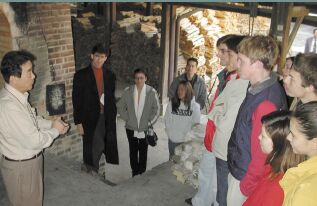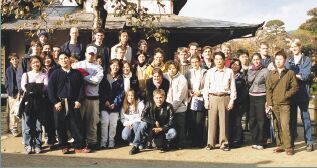Foreign students at Kyushu University, as members of the JTW program, are able to participate in weekly field study trips. These field study trips provide us the opportunity to examine and participate in different aspects of Japanese society. Attendance of the field trips is also mandatory, providing a nice opportunity for administration to maintain a shepherd's gaze on student behavior.
This past November, we went to Arita, a town in the neighboring prefecture of Saga, to observe ceramics production and history. We visited two production facilities, of which one was the Kakiemon kiln.
Kakiemon is currently a fashionable brand name. But Kakiemon is also a person - the master potter of the kiln who designs pieces produced and the artwork inscribed on them, and a designated "living national treasure" of Japan. Mr. Kakiemon was designated by the Japanese government as a "living national treasure" because his artwork typifies aesthetic values which are thought of as uniquely Japanese.
Well, I am not sure exactly how one would go about determining typical aesthetic values of a country, nor deeming any artist typical of those values. But in any case, upon Kakiemon and his kiln this honor is bestowed.

All of the JTW students had the chance to listen to a brief talk given by Mr. Kakiemon. He talked about ceramics making, as well as the long history surrounding the pottery process, and how it evolved out of Korean pottery making techniques. We also took a tour of the Kakiemon facilities, and saw the pottery making techniques firsthand. I never realized how elaborate the process of making pottery actually is. Likewise, the time and specialization involved in the craft.
Upon reflection, I think the highlight of the trip was visiting the Kakiemon kiln and talking to Mr. Kakiemon. At first, I thought it must be a great honor to be a "living national treasure."
I wonder how much being a living treasure stresses Kakiemon, or affects his work as an artist. I remember watching the potters at the kiln, working on the various pieces, unified in silence and intense concentration. At once working at the Kakiemon kiln must be a great honor. At the same time, it must mean assuming a lot of responsibility.
Later that day, we took a tour of the Shibata collection - a collection of various antique potteries produced in the area throughout history - and watched a presentation about the collection. Many watched, many slept, but at the end of the presentation, I think all students were more knowledgeable about the evolution of pottery. The actual viewing of the pottery collection was interesting as well, pieces dating back hundreds of years.
 |
Nicholas Klofkorn |
| JTW student | |
| (University of Michigan, USA) |
On a more personal level, if participation wasn't required, I probably wouldn't have met Mr. Kakiemon. I know that Japan is renowned for having advanced pottery making techniques. From what I had seen and heard about before coming to Japan I was impressed, and I think Japanese pottery is wonderful and unique. Now, I am more aware of the time, dedication and skill involved in the process. That being said, I think that it was great that as students we had the opportunity to participate in this extravaganza.
